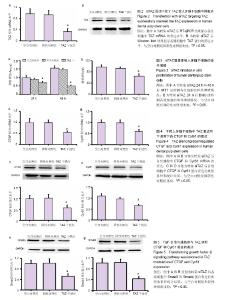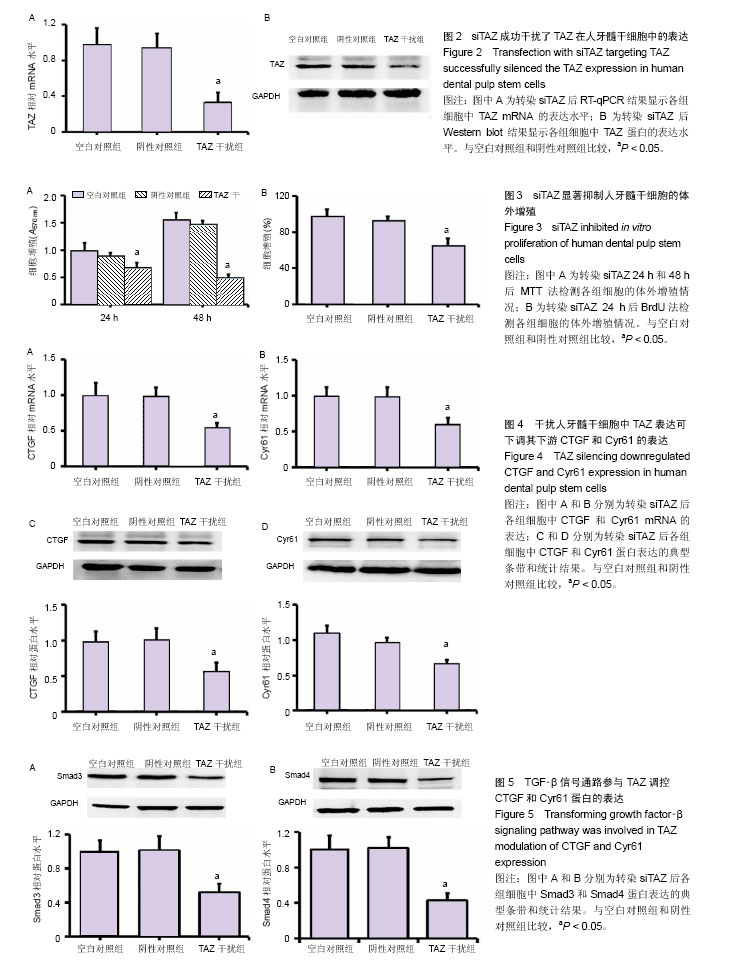Chinese Journal of Tissue Engineering Research ›› 2018, Vol. 22 ›› Issue (9): 1457-1462.doi: 10.3969/j.issn.2095-4344.0479
Previous Articles Next Articles
Effects of TAZ, a transcriptional coactivator, on human dental pulp stem cell proliferation in vitro
Zhang Wen1, Luo Shi-wei1, Gu Ai-ling2, He Wei1
- 1Oral Medicine Center, the First Affiliated Hospital of Zhengzhou University, Zhengzhou 450052, Henan Province, China; 2Puyang People’s Hospital, Puyang 457099, Henan Province, China
-
Revised:2017-10-10Online:2018-03-28Published:2018-04-03 -
Contact:He Wei, M.D., Chief physician, Oral Medicine Center, the First Affiliated Hospital of Zhengzhou University, Zhengzhou 450052, Henan Province, China -
About author:Zhang Wen, Master, Oral Medicine Center, the First Affiliated Hospital of Zhengzhou University, Zhengzhou 450052, Henan Province, China
CLC Number:
Cite this article
Zhang Wen, Luo Shi-wei, Gu Ai-ling, He Wei. Effects of TAZ, a transcriptional coactivator, on human dental pulp stem cell proliferation in vitro[J]. Chinese Journal of Tissue Engineering Research, 2018, 22(9): 1457-1462.
share this article

2.1 人牙髓干细胞形态及TAZ表达 通过胰蛋白酶消化法获得人原代牙髓干细胞,主要为成纤维样细胞,其形态多为梭形(图1A)。人牙髓干细胞传至3-5代后,利用细胞免疫荧光法检测TAZ蛋白表达,结果显示人牙髓干细胞TAZ蛋白表达呈阳性,且与细胞核共定位(图1B-D),以上结果成功证实人牙髓干细胞中有TAZ蛋白表达。 2.2 TAZ靶向小干扰RNA(siTAZ)下调了人牙髓干细胞中TAZ的mRNA和蛋白表达 为了探索TAZ对人牙髓干细胞体外增殖的影响,首先设计合成了干扰TAZ表达的小干扰RNA(siTAZ)。如图2所示,在成功转染siTAZ 48 h之后,RT-qPCR(图2A)和Western blot(图2B)结果均一致显示,siTAZ组的TAZ mRNA和TAZ蛋白表达水平均较对照组显著降低,提示siTAZ可以有效地沉默TAZ在人牙髓干细胞中的表达。 2.3 siTAZ抑制了人牙髓干细胞的体外增殖 采用MTT法检测各组细胞的体外增殖情况,如图3A所示,在siTAZ转染后24 h,siTAZ组的细胞增殖速度已显著低于空白对照组和阴性对照组;在转染后48 h,上述抑制作用较前进一步增强。为进一步验证上述实验结果,又采用BrdU细胞增殖法检测各组细胞的体外增殖情况,与MTT法检测结果类似,siTAZ组的细胞增殖速度显著低于空白对照组和阴性对照组(图3B)。以上结果提示,沉默TAZ的表达可以显著抑制人牙髓干细胞的体外增殖。 2.4 siTAZ通过下调CTGF和Cyr61的表达而抑制人牙髓干细胞的体外增殖 前期已有报道显示CTGF和Cyr61作为TAZ下游作用的重要靶蛋白,其可能与细胞的增殖、迁移和凋亡等有密切联系。因此,为进一步探索siTAZ抑制人牙髓干细胞体外增殖的潜在分子机制,实验分别检测了TAZ被沉默表达之后CTGF和Cyr61在mRNA和蛋白水平的表达变化。结果如图4所示,无论是在mRNA水平还是蛋白水平,siTAZ组CTGF和Cyr61的表达水平均较空白对照组和阴性对照组显著降低,这提示siTAZ可能是通过干扰TAZ表达,进而抑制其下游CTGF和Cyr61蛋白的表达而最终影响了人牙髓干细胞的体外增殖。 2.5 siTAZ通过TGF?β介导的信号通路来下调CTGF和Cyr61蛋白的表达 有研究报道TAZ可能通过TGF?β信号通路参与对CTGF和Cyr61蛋白的调控,因此,为深入探索siTAZ下调CTGF和Cyr61蛋白表达的分子机制,进一步检测了siTAZ转染后TGF?β信号通路中重要分子Smad3和Smad4的表达变化。结果如图5所示,siTAZ组Smad3和Smad4的表达水平均较空白对照组和阴性对照组显著降低,提示TGF?β信号通路可能参与了TAZ调控CTGF和 Cyr61蛋白的表达。"

| [1] Downing TL, Soto J, Morez C, et al. Biophysical regulation of epigenetic state and cell reprogramming. Nat Mater. 2013; 12(12):1154-1162.[2] Karaöz E, Demircan PC, Sa?lam O, et al. Human dental pulp stem cells demonstrate better neural and epithelial stem cell properties than bone marrow-derived mesenchymal stem cells. Histochem Cell Biol. 2011;136(4):455-473. [3] Liu P, Cai J, Dong D, et al. Effects of SOX2 on Proliferation, Migration and Adhesion of Human Dental Pulp Stem Cells. PLoS One. 2015;10(10):e0141346. [4] Liu L, Wu L, Wei X, et al. Induced overexpression of Oct4A in human dental pulp cells enhances pluripotency and multilineage differentiation capability. Stem Cells Dev. 2015;24(8):962-972. [5] Jayaraman P, Govindasamy V, Gnanasegaran N, et al. Expression patterns of immune genes in long-term cultured dental stem cells. Clin Oral Investig. 2016;20(1):109-116.[6] Han SM, Han SH, Coh YR, et al. Enhanced proliferation and differentiation of Oct4- and Sox2-overexpressing human adipose tissue mesenchymal stem cells. Exp Mol Med. 2014;46:e101. [7] Liu L, Wei X, Ling J, et al. Expression pattern of Oct-4, Sox2, and c-Myc in the primary culture of human dental pulp derived cells. J Endod. 2011;37(4):466-472. [8] Jeong H, Bae S, An SY, et al. TAZ as a novel enhancer of MyoD-mediated myogenic differentiation. FASEB J. 2010; 24(9):3310-3320.[9] Luo Z, Li D, Kohli MR, et al. Effect of Biodentine™ on the proliferation, migration and adhesion of human dental pulp stem cells. J Dent. 2014;42(4):490-497.[10] Tate MC, García AJ, Keselowsky BG, et al. Specific beta1 integrins mediate adhesion, migration, and differentiation of neural progenitors derived from the embryonic striatum. Mol Cell Neurosci. 2004;27(1):22-31.[11] Kanai F, Marignani PA, Sarbassova D, et al. TAZ: a novel transcriptional co-activator regulated by interactions with 14-3-3 and PDZ domain proteins. EMBO J. 2000;19(24): 6778-6791.[12] Tian S, Tian X, Liu Y, et al. Effects of TAZ on human dental pulp stem cell proliferation and migration. Mol Med Rep. 2017;15(6):4326-4332.[13] Pan D.The hippo signaling pathway in development and cancer. Dev Cell. 2010;19(4):491-505.[14] Hong JH, Yaffe MB. TAZ: a beta-catenin-like molecule that regulates mesenchymal stem cell differentiation. Cell Cycle. 2006;5(2):176-179.[15] Hong JH, Hwang ES, McManus MT, et al. TAZ, a transcriptional modulator of mesenchymal stem cell differentiation. Science. 20052;309(5737):1074-1078.[16] Murakami M, Nakagawa M, Olson EN, et al. A WW domain protein TAZ is a critical coactivator for TBX5, a transcription factor implicated in Holt-Oram syndrome. Proc Natl Acad Sci U S A. 2005;102(50):18034-18039. [17] Park KS, Whitsett JA, Di Palma T, et al. TAZ interacts with TTF-1 and regulates expression of surfactant protein-C. J Biol Chem. 2004;279(17):17384-17390.[18] Suh JS, Kim KS, Lee JY, et al. A cell-permeable fusion protein for the mineralization of human dental pulp stem cells. J Dent Res. 2012;91(1):90-96. [19] Iohara K, Zheng L, Wake H, et al. A novel stem cell source for vasculogenesis in ischemia: subfraction of side population cells from dental pulp. Stem Cells. 2008;26(9):2408-2418. [20] Nakamura S, Yamada Y, Katagiri W, et al. Stem cell proliferation pathways comparison between human exfoliated deciduous teeth and dental pulp stem cells by gene expression profile from promising dental pulp. J Endod. 2009;35(11):1536-1542. [21] La Noce M, Paino F, Spina A, et al. Dental pulp stem cells: state of the art and suggestions for a true translation of research into therapy. J Dent. 2014;42(7):761-768.[22] Liu J, Yu F, Sun Y, et al. Concise reviews: Characteristics and potential applications of human dental tissue-derived mesenchymal stem cells. Stem Cells. 2015;33(3):627-638.[23] Tirino V, Paino F, d'Aquino R, et al. Methods for the identification, characterization and banking of human DPSCs: current strategies and perspectives. Stem Cell Rev. 2011;7(3): 608-615. [24] Conde MC, Nedel F, Campos VF, et al. Odontoblast RNA stability in different temperature-based protocols for tooth storage. Int Endod J. 2012;45(3):266-272.[25] Hong W, Guan KL.The YAP and TAZ transcription co-activators: key downstream effectors of the mammalian Hippo pathway. Semin Cell Dev Biol. 2012;23(7):785-793.[26] Wang K, Degerny C, Xu M, et al. YAP, TAZ, and Yorkie: a conserved family of signal-responsive transcriptional coregulators in animal development and human disease. Biochem Cell Biol. 2009;87(1):77-91.[27] Zeng Q, Hong W. The emerging role of the hippo pathway in cell contact inhibition, organ size control, and cancer development in mammals. Cancer Cell. 2008;13(3):188-192. [28] Lei QY, Zhang H, Zhao B, et al. TAZ promotes cell proliferation and epithelial-mesenchymal transition and is inhibited by the hippo pathway. Mol Cell Biol. 2008;28(7): 2426-2436. [29] Chan SW, Lim CJ, Guo K, et al. A role for TAZ in migration, invasion, and tumorigenesis of breast cancer cells. Cancer Res. 2008;68(8):2592-2598.[30] Wang Q, Xu Z, An Q, et al. TAZ promotes epithelial to mesenchymal transition via the upregulation of connective tissue growth factor expression in neuroblastoma cells. Mol Med Rep. 2015;11(2):982-988.[31] Dhar A, Ray A.The CCN family proteins in carcinogenesis. Exp Oncol. 2010;32(1):2-9. [32] Leivonen SK, Kähäri VM. Transforming growth factor-beta signaling in cancer invasion and metastasis. Int J Cancer. 2007;121(10):2119-2124.[33] Kim KM, Choi YJ, Hwang JH, et al. Shear stress induced by an interstitial level of slow flow increases the osteogenic differentiation of mesenchymal stem cells through TAZ activation. PLoS One. 2014;9(3):e92427.[34] Xie JJ, Xu LY, Wu JY, et al. Involvement of CYR61 and CTGF in the fascin-mediated proliferation and invasiveness of esophageal squamous cell carcinomas cells. Am J Pathol. 2010;176(2):939-951.[35] Labbé E, Lock L, Letamendia A, et al. Transcriptional cooperation between the transforming growth factor-beta and Wnt pathways in mammary and intestinal tumorigenesis. Cancer Res. 2007;67(1):75-84. |
| [1] | Li Xuan, Sun Yimin, Li Longbiao, Wang Zhenming, Yang Jing, Wang Chenglin, Ye Ling. Manufacturing of nano-modified polycaprolactone microspheres and its biological effects in dental pulp cells [J]. Chinese Journal of Tissue Engineering Research, 2022, 26(10): 1602-1608. |
| [2] | Liu Xiaogang, Li Tian, Zhang Duo. Effect and mechanism of the effective components of Chinese medicine on promoting the differentiation of bone marrow mesenchymal stem cells into chondrocytes [J]. Chinese Journal of Tissue Engineering Research, 2022, 26(1): 121-126. |
| [3] | Wei Shan, Li Qin, Su Yi. Research hotspots and application potential of stem cells from human exfoliated deciduous teeth [J]. Chinese Journal of Tissue Engineering Research, 2022, 26(1): 127-131. |
| [4] | Mai Liping, He Guodong, Chen Shaoxian, Zhu Jiening, Hou Xinghua, Zhang Mengzhen, Li Xiaohong. Expression of aldehyde dehydrogenase 3B1 during human bone marrow mesenchymal stem cells senescence [J]. Chinese Journal of Tissue Engineering Research, 2022, 26(1): 40-44. |
| [5] | Yang Tengyun, Li Yanlin, Liu Dejian, Wang Guoliang, Zheng Zhujun. Chondrogenic differentiation of peripheral blood-derived mesenchymal stem cells induced by transforming growth factor beta 3: a dose-effect relationship [J]. Chinese Journal of Tissue Engineering Research, 2022, 26(1): 45-51. |
| [6] | Meng Defeng, Li Changzai, Wu Chuntao. Effects of LINC02532 targeting miR-145 on proliferation, migration, invasion and apoptosis of pancreatic cancer stem cells [J]. Chinese Journal of Tissue Engineering Research, 2022, 26(1): 52-58. |
| [7] | Yao Yanyi, Chen Xiaoling, Zhang Min, Wang Hong, Hao Liying, Shi Chao, Zhao Bingfeng, Jin Yaqiao, Dong Wei. miR-210/YWHAG axis with adipocyte proliferation and angiogenesis after autologous fat transplantation [J]. Chinese Journal of Tissue Engineering Research, 2022, 26(1): 59-63. |
| [8] | Huang Tao, Cheng Zhijian, Jia Zhiqiang, Zhao Xiaoguang, Wang Lei, Zhai Wenjing, Zhou Yongxin. Mechanism by which miR-146a regulates osteogenic differentiation of adipose derived mesenchymal stem cells [J]. Chinese Journal of Tissue Engineering Research, 2022, 26(1): 70-75. |
| [9] | Sun Mengjun, Guo Jianmei, Zhou Gengsu, Dong Zefei, Zheng Chungui, Cao Cuili. Expression and significance of DNA topoisomerase II in neural stem cells of ICR mice [J]. Chinese Journal of Tissue Engineering Research, 2022, 26(1): 84-89. |
| [10] | Jing Jin, Zhao Shandi, Chen Long, Peng Shuanglin, Tang Hui, Guo Daijin, Zeng Xinyi, Xiao Jingang. Repair of calvarial defects in osteoporotic mice by adipose-derived stem cells combined with biphasic calcium phosphate ceramic scaffold [J]. Chinese Journal of Tissue Engineering Research, 2022, 26(1): 90-95. |
| [11] | Cui Shuaishuai, Yang Xiaohong. Effects of miRNA in self-renewal, multidirectional differentiation, fate and function regulation of bone marrow mesenchymal stem cells [J]. Chinese Journal of Tissue Engineering Research, 2022, 26(1): 101-106. |
| [12] | Kang Yue, Liu Jie. Biological function of circular RNAs in osteogenic differentiation of mesenchymal stem cells [J]. Chinese Journal of Tissue Engineering Research, 2022, 26(1): 107-112. |
| [13] | Feng Zhiguo, Sun Haibiao, Han Xiaoqiang. Regulation of proliferation, differentiation and apoptosis of bone-related cells by long-stranded non-coding RNA [J]. Chinese Journal of Tissue Engineering Research, 2022, 26(1): 113-120. |
| [14] | Shuai Zhiqin, Chen Jiameng, Liu Taotao, Hu Anling, Li Lisheng, Yu Limei, Xu Shangfu. Research status and problems of stem cells and their derived exosomes for prevention and treatment of vascular restenosis [J]. Chinese Journal of Tissue Engineering Research, 2022, 26(1): 138-144. |
| [15] | Li Zhongkang, Zheng Jiahua, Tian Yanpeng, Huang Xianghua. Latest progress and mechanisms of mesenchymal stem cells on premature ovarian failure [J]. Chinese Journal of Tissue Engineering Research, 2022, 26(1): 145-152. |
| Viewed | ||||||
|
Full text |
|
|||||
|
Abstract |
|
|||||

